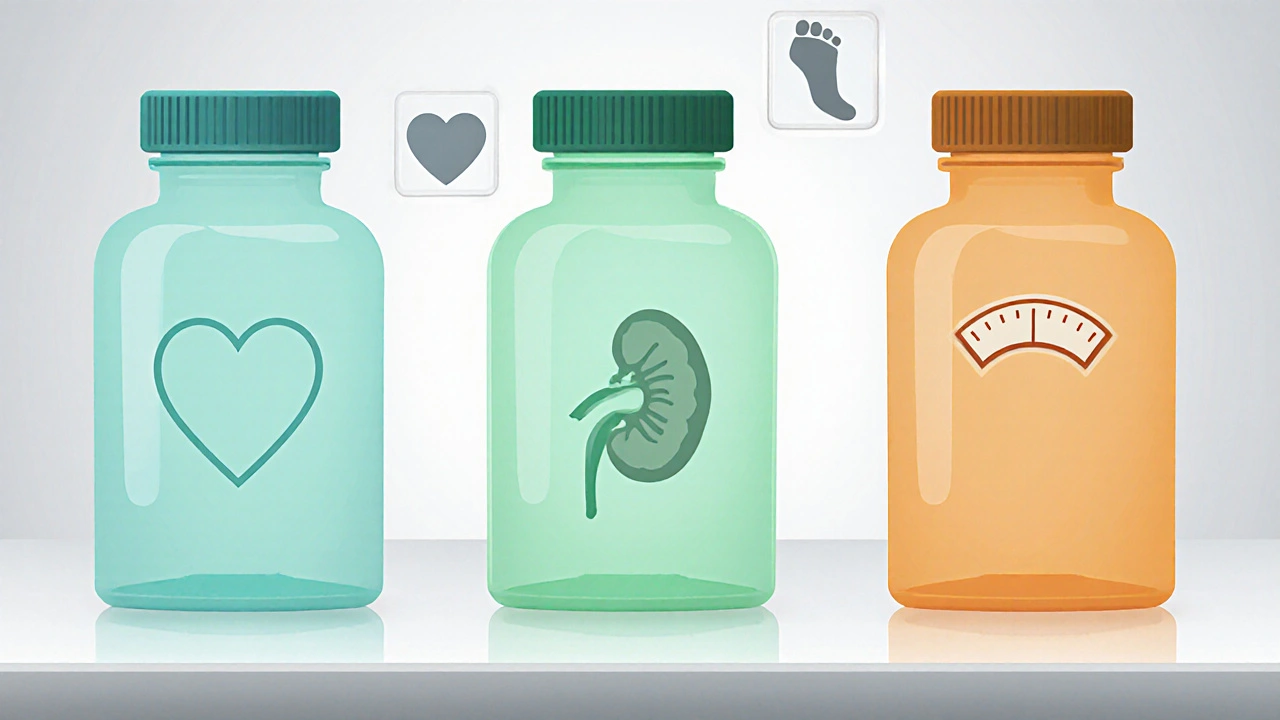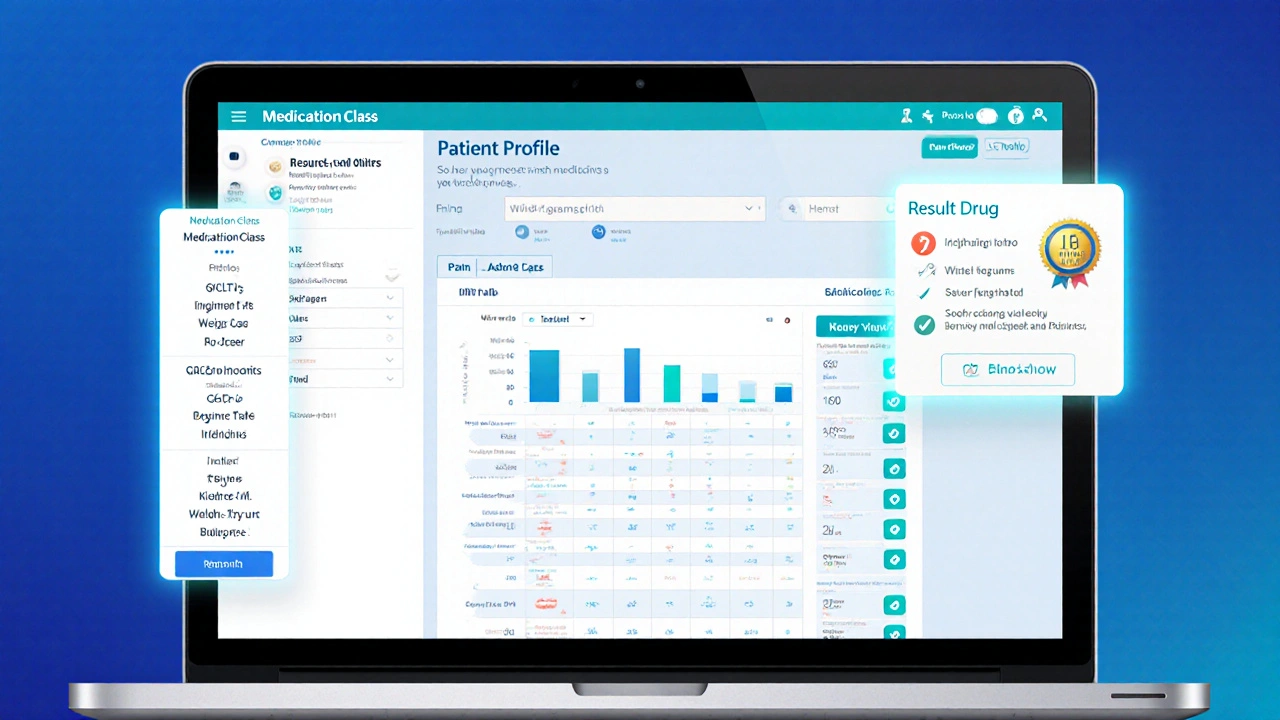Empagliflozin vs Other Diabetes Drugs Comparison Tool
| Medication | A1C Reduction | Cardiovascular Benefit | Weight Loss | Administration | Safety Profile |
|---|
When you or someone you care for is prescribed a new drug for type 2 diabetes, the first question is usually, “How does this stack up against the other options?” Empagliflozin has become a go‑to choice for many clinicians, but it’s not the only player in the field. This guide breaks down what empagliflozin does, how it differs from its closest rivals, and what factors you should weigh before deciding which pill fits best.
Key Takeaways
- Empagliflozin is an SGLT2 inhibitor that lowers blood sugar, reduces cardiovascular risk, and may aid weight loss.
- Compared with dapagliflozin and canagliflozin, empagliflozin shows slightly stronger heart‑protective data but similar glycemic efficacy.
- GLP‑1 receptor agonists (e.g., liraglutide) provide greater A1C drops and weight loss but require injections.
- Cost and insurance coverage vary widely; empagliflozin’s price is often comparable to other SGLT2 inhibitors but lower than many GLP‑1 drugs.
- Choosing the right drug depends on cardiovascular history, kidney function, weight goals, and personal preferences.
Empagliflozin is a sodium‑glucose co‑transporter‑2 (SGLT2) inhibitor approved in 2014 for type 2 diabetes. It works by blocking the SGLT2 protein in the kidney, which reduces glucose re‑absorption and pushes excess sugar into the urine. This mechanism not only cuts fasting and post‑meal glucose levels but also produces a modest calorie loss, helping many patients shed a few pounds.
Beyond blood‑sugar control, the EMPA‑REG OUTCOME trial (2015) showed a 38% reduction in cardiovascular death and a 35% drop in heart‑failure hospitalization for patients on empagliflozin. The drug also slows the progression of diabetic kidney disease, making it attractive for patients with early chronic kidney disease (CKD).
How Empagliflozin Measures Up Against Other SGLT2 Inhibitors
All SGLT2 inhibitors share the same basic mechanism, but subtle differences in trial data, dosing, and safety profiles matter.
Dapagliflozin entered the market a year after empagliflozin. It is taken once daily at 5-10mg. The DECLARE‑TIMI 58 trial (2019) demonstrated a 17% reduction in cardiovascular death or heart‑failure hospitalization, which is less pronounced than empagliflozin’s 38% figure. However, dapagliflozin has strong evidence for heart‑failure with reduced ejection fraction (HFrEF) even in patients without diabetes.
Canagliflozin was the first SGLT2 inhibitor approved (2013). Typical dosing is 100mg or 300mg once daily. The CANVAS Program (2017) reported a 14% reduction in major adverse cardiovascular events (MACE) and a 33% drop in heart‑failure hospitalizations. Canagliflozin also showed a modest benefit in slowing renal decline, similar to empagliflozin, but it carries a higher risk of lower‑leg amputations (a signal that faded in later analyses).
| Drug | Typical Dose | A1C Reduction (avg.) | Cardiovascular Benefit | Kidney Protection | Key Safety Concerns |
|---|---|---|---|---|---|
| Empagliflozin | 10mg daily | ‑0.7% | 38% ↓ CV death, 35% ↓ HF hospitalization | Slows eGFR decline, ↓ albuminuria | Genital infections, volume depletion |
| Dapagliflozin | 5-10mg daily | ‑0.6% | 17% ↓ CV death or HF hospitalization | Effective in HFrEF, modest renal benefit | Genital infections, rare ketoacidosis |
| Canagliflozin | 100mg or 300mg daily | ‑0.8% | 14% ↓ MACE, 33% ↓ HF hospitalization | Renal protection similar to empagliflozin | Amputation signal, genital infections |

Comparing SGLT2 Inhibitors to Other Diabetes Classes
In many treatment algorithms, SGLT2 inhibitors are paired with metformin, but they also compete with GLP‑1 receptor agonists, DPP‑4 inhibitors, and sulfonylureas. Below is a quick snapshot of how empagliflozin stacks up against those alternatives.
Liraglutide (a GLP‑1 receptor agonist) delivers an average A1C drop of 1.1% and often yields 5-10lb of weight loss, outperforming empagliflozin on both fronts. Its biggest advantage is a robust reduction in major adverse cardiovascular events (up to 26% in the LEADER trial). The downside? It’s injectable, more expensive, and can cause nausea.
Sitagliptin (a DPP‑4 inhibitor) is oral, well‑tolerated, and cheap, but it only reduces A1C by about 0.5% and adds little weight loss or cardiovascular benefit. It’s sometimes used when patients can’t tolerate SGLT2 inhibitors.
Metformin remains first‑line therapy for most patients. It cuts A1C by 1-1.5%, modestly aids weight loss, and has a solid safety record. However, it offers no proven heart‑failure or renal protection, which is where empagliflozin shines.
Decision Criteria: When to Pick Empagliflozin
- Cardiovascular disease or high risk: Empagliflozin’s mortality benefit makes it a top choice for anyone with established ASCVD or multiple risk factors.
- Heart‑failure history: Both empagliflozin and dapagliflozin reduce HF hospitalizations, but empagliflozin has the larger mortality signal.
- Kidney function: Empagliflozin is approved down to eGFR30mL/min/1.73m² (and now 20mL/min in some regions). It can be continued as long as eGFR stays above that threshold.
- Weight‑loss goals: Expect a 2-3lb loss with empagliflozin; GLP‑1 agents give more, but at the cost of injections.
- Preference for oral medication: If injection aversion is a deal‑breaker, empagliflozin beats liraglutide.
- Cost considerations: Generic empagliflozin (available 2023) is usually cheaper than brand‑only GLP‑1 drugs, and pricing is comparable to dapagliflozin and canagliflozin.
Practical Checklist for Clinicians and Patients
- Confirm type2 diabetes diagnosis and baseline A1C.
- Assess cardiovascular history - prior MI, stroke, or HF?
- Check kidney function (eGFR) and ensure it’s ≥30mL/min/1.73m².
- Discuss weight‑loss expectations and willingness to inject.
- Review medication list for potential interactions (e.g., loop diuretics may increase dehydration risk).
- Choose dose: start 10mg daily; consider 25mg if tolerated and additional A1C lowering needed.
- Plan follow‑up labs at 3months: A1C, eGFR, electrolytes.
- Monitor for genital mycotic infections - educate on hygiene and early treatment.
- Re‑evaluate cardiovascular status annually; adjust therapy if newer evidence emerges.

Frequently Asked Questions
Can I take empagliflozin if I have chronic kidney disease?
Yes, empagliflozin is approved for patients with an eGFR down to 30mL/min/1.73m², and recent data suggest it remains safe even at 20mL/min, though clinicians should monitor renal labs closely.
How does empagliflozin affect blood pressure?
Because it promotes osmotic diuresis, empagliflozin often lowers systolic blood pressure by 3-5mmHg, which can be beneficial for hypertensive patients.
Are there any dietary restrictions while on empagliflozin?
No specific diet is required, but maintaining adequate hydration is crucial to reduce the risk of volume depletion and kidney injury.
What should I do if I develop a yeast infection?
Over‑the‑counter antifungal creams (e.g., clotrimazole) are effective. If infections recur, talk to your doctor about lowering the dose or switching drugs.
Is empagliflozin safe during pregnancy?
SGLT2 inhibitors are not recommended in pregnancy or breastfeeding because of limited safety data; metformin or insulin are preferred alternatives.
In short, empagliflozin offers a solid blend of blood‑sugar control, heart‑health protection, and modest weight loss, all in a once‑daily pill. If cardiovascular disease, kidney concerns, or a desire to stay oral are top priorities, it often edges out dapagliflozin, canagliflozin, and many non‑SGLT2 options. For those chasing the biggest A1C drop or willing to inject, a GLP‑1 agonist may still be the winner. Use the checklist, weigh the criteria, and you’ll land on the drug that matches the individual’s health profile and lifestyle.


Graham Holborn
Hi, I'm Caspian Osterholm, a pharmaceutical expert with a passion for writing about medication and diseases. Through years of experience in the industry, I've developed a comprehensive understanding of various medications and their impact on health. I enjoy researching and sharing my knowledge with others, aiming to inform and educate people on the importance of pharmaceuticals in managing and treating different health conditions. My ultimate goal is to help people make informed decisions about their health and well-being.